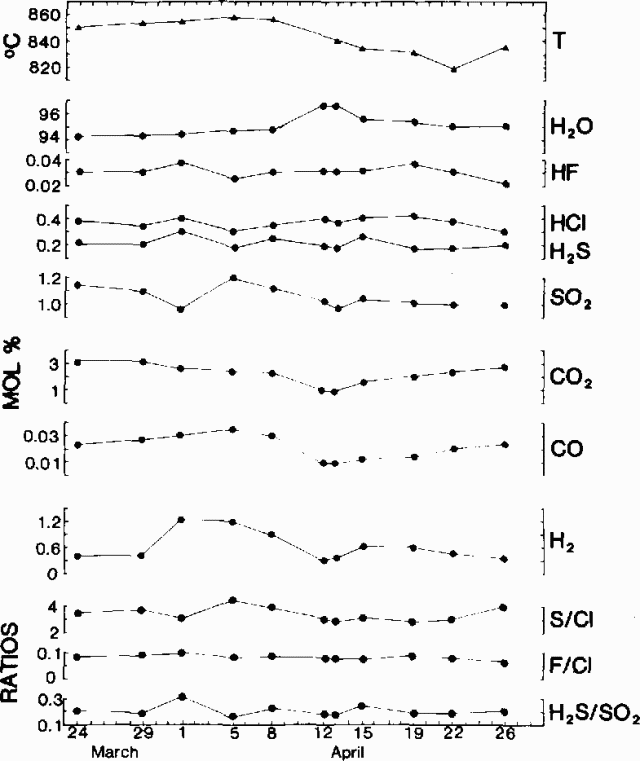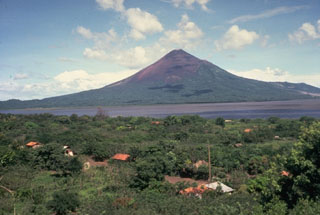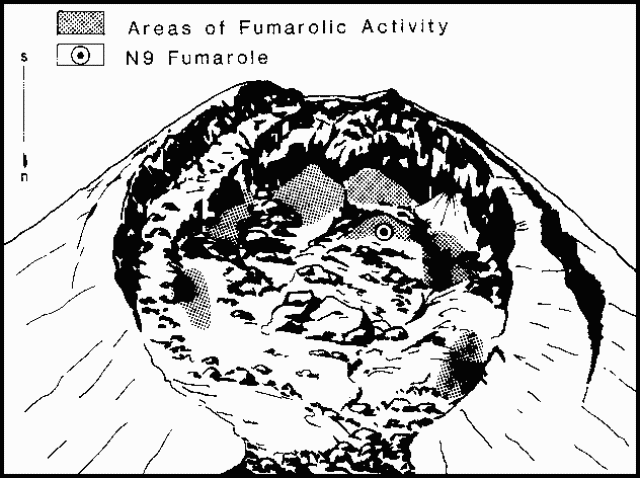Report on Momotombo (Nicaragua) — May 1983
Scientific Event Alert Network Bulletin, vol. 8, no. 5 (May 1983)
Managing Editor: Lindsay McClelland.
Momotombo (Nicaragua) Fumarole chemistry changes and temperature drops after tremor ends
Please cite this report as:
Global Volcanism Program, 1983. Report on Momotombo (Nicaragua) (McClelland, L., ed.). Scientific Event Alert Network Bulletin, 8:5. Smithsonian Institution. https://doi.org/10.5479/si.GVP.SEAN198305-344090
Momotombo
Nicaragua
12.423°N, 86.539°W; summit elev. 1270 m
All times are local (unless otherwise noted)
"In mid-March 1983 a joint Soviet-Nicaraguan team began a 3-month program of continuous observations of fumarolic activity in Momotombo's summit crater. The observations included temperature measurements and gas sampling from the highest temperature fumarole (N 9; figure 1). Immediately after sampling, the gas samples were analyzed in a field chemical laboratory near the volcano. CH2, O2, and N2 contents were determined and the S/Cl, F/Cl, and H2S/SO2 ratios were calculated, as well as the analyses shown in figure 2.
 |
Figure 2. Temperature in °C (top), gas concentrations in mole % (center), and gas concentration ratios (bottom), at Momotombo's fumarole N 9, 24 March-26 April 1983. |
"During the initial period of observations (27 March-5 April) a gradual temperature rise from 851° to 858°C was noted, as well as a negligible increase in H2O and a more appreciable increase in reduced gases (H2S, H2, and CO). The seismic station registered volcanic tremor that appeared 17 March and stopped 4 April. When the tremor disappeared the temperature of fumarole N 9 immediately fell sharply, dropping 15°C in 4 days and continuing downward to 815°C by 22 April (figure 2). Simultaneous with the falling temperature, an increase in H2O content from 94.1 to 96.7 mole % and decreasing proportions of CO2, H2, CO, and other gases were registered. After 15 April the H2O content gradually decreased, reaching previous values at the end of April. The concentrations of other gases also reached previous values by that time.
"Although the variations in the temperature and gas compositions of N 9 fumarole were very appreciable, the S/Cl, F/Cl, and H2S/SO2 ratios fluctuated inside very narrow ranges of values. This fact gave us the chance to assume that no eruptive activity occurred at Momotombo during the period of observations."
Geological Summary. Momotombo is a young stratovolcano that rises prominently above the NW shore of Lake Managua, forming one of Nicaragua's most familiar landmarks. Momotombo began growing about 4500 years ago at the SE end of the Marrabios Range and consists of a somma from an older edifice that is surmounted by a symmetrical younger cone with a 150 x 250 m wide summit crater. Young lava flows extend down the NW flank into the 4-km-wide Monte Galán caldera. The youthful cone of Momotombito forms an island offshore in Lake Managua. Momotombo has a long record of Strombolian eruptions, punctuated by occasional stronger explosive activity. The latest eruption, in 1905, produced a lava flow that traveled from the summit to the lower NE base. A small black plume was seen above the crater after a 10 April 1996 earthquake, but later observations noted no significant changes in the crater. A major geothermal field is located on the south flank.
Information Contacts: I. Menyailov, V. Shapar, L. Gartzeva, and V. Pilipenko, IVP, Kamchatka; R. Argeñal, D. Fajardo B., and R. Espinoza, INETER; I. Vallecillo, Proyecto Geotérmico.


